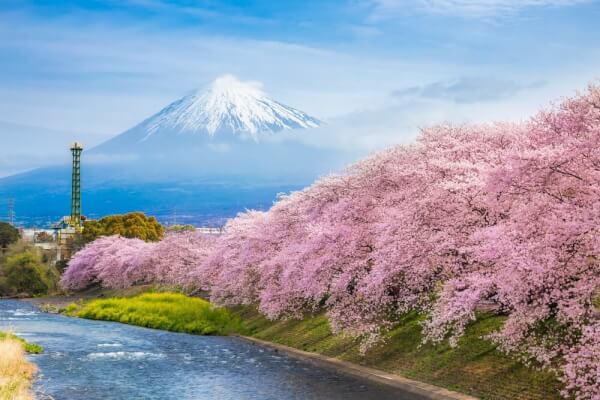Is tap water in Japan safe to drink? A traveller's guide
Planning a trip to Japan? Discover if tap water is safe to drink for travellers. This is your guide on Japan's water quality.

Whether you’re dreaming of cherry blossoms in Kyoto, the neon-lit streets of Tokyo, or hitting the slopes in Hokkaido, planning a trip to Japan is exciting! It’s a fascinating country to visit, but does come with a few unique customs and travel considerations that can surprise first time visitors.
From understanding the best time to visit and the must-have apps to navigating the transport system and staying connected, we’re sharing a few key travel tips that can make your journey smoother and more enjoyable. We’ll also introduce you to Wise, a handy travel companion to manage your money abroad, offering fair exchange rates and seamless spending in Japan.
To start, you want to choose the best time of year to visit Japan so that you can see and do everything you hope to.
Spring is the season of cherry blossoms, known in Japan as sakura. The flowers bloom in hues of pink, lining the streets with colour and creating picturesque scenes across the country.
Summer is a time to visit the lakes and beaches of Japan, and join in on local festivities such as the historic Gion Matsuri in Kyoto or the Nebuta Matsuri lantern festival in Aomori City.¹
During Autumn, the leaves start to change with the colourful fall foliage coming through. This can be a particularly beautiful sight to take in at a traditional Japanese garden or across Lake Kawaguchiko looking up to Mt Fuji.
For much of Japan, Winter means snow, so that’s the time of year to go if you're looking to hit the slopes and go skiing or snowboarding. It’s also the perfect time to visit a hot spring like the famous Jigokudani Snow Monkey Park.
| Check out Best Time to Visit Japan for all you need to know 🌸🇯🇵 |
|---|
Travelling to Japan is much easier if you have access to reliable internet. Free Wi-Fi isn’t always available so instead consider renting a portable Wi-Fi device or buying an eSIM.
A portable Wi-Fi is a wireless hotspot small enough to fit in the palm of your hand. It’s a good option if you have multiple devices, want to share Wi-Fi with a travel buddy or don’t have an eSIM capable phone.
If you just want data on your phone and it’s eSIM compatible then you could buy yourself an eSIM to stay connected. There are providers that specialise in travel eSIMs which may work out to be more cost effective than using international roaming.
When travelling abroad your phone and the apps on it are an essential resource. To start, make sure you have Google Translate and if you’re relying on Wi-Fi for data, make sure you download Japanese offline.
Google Maps makes it easier to find attractions and navigate your way around Japan, even providing up to date public transport information for some cities.
Rather than Uber, take a look at the very popular Go Taxi app for booking a ride. Don’t worry, it supports English and Japanese.
To find good restaurants and even make a reservation there’s Tabelog or Rakuten GURUNAVI. Both have English language options and make it easier to find somewhere to eat based on location and food categories.
If there are certain attractions you’re planning to visit it’s worth checking to see if they have an app. For example, the Edo-Tokyo Museum has released a series of Hyper Edohaku apps, while theme parks like Tokyo Disney have apps that allow you to manage your in-park experience.
Some Japanese businesses may still be cash only, especially in rural areas, so having cash on hand is a good idea. There’s also Japan’s iconic vending machines which take cash and can sell everything from the normal snacks and drinks to cotton candy, macaroons, and even a bowl of ramen.
One of the easiest ways to get cash in Japan is to go to an ATM and withdraw it. Many travellers suggest using the 7-Eleven or Aeon ATMs based on experiencing no withdrawal fees.
Japan is a shopper’s paradise, offering everything from gadgets and luxury fashion to unique souvenirs. With tax-free shopping, it's easier to indulge. However, using the wrong card can be an expensive mistake, with hidden fees and poor exchange rates.
That’s where the Wise card comes in. It saves you money with the mid-market exchange rate and no foreign transaction fees, usually offering the best value for your money. You can use your card in 150+ countries, including Japan, and spend like a local. The card supports contactless payments, works with digital wallets like Apple Pay, and allows free ATM withdrawals each month. Plus, you’ll get real-time notifications to track your spending.
Throughout your trip, you can manage everything from the Wise app, so you’re always in control of your money. If your card gets lost or misplaced, you can instantly freeze and unfreeze it for peace of mind.
Please see Terms of Use and product availability for your region or visit Wise Fees & Pricing for the most up to date pricing and fee information.
In Japan you can buy rechargeable cards to pay for public transport which helps streamline your travels. These cards can also be accepted as a payment method at participating convenience stores, vending machines and lockers.³ Two of the main options are Suica and Pasmo.
To get a Suica or Pasmo card you can buy them at a JR station or private station respectively, using your Wise card to pay in Japanese yen so you get a good exchange rate. When it’s time to top up that can also be done at a station, or alternatively the digital Suica card can be topped up via ApplePay on your phone.
When using digital wallets like ApplePay, it’s a good idea to connect them to a digital card, like the Wise digital card, rather than your physical card. The layer of separation gives you a bit of extra security and with Wise, you can easily and instantly freeze, delete and replace digital cards whenever you want.
Created just for foreigners who are sight seeing in Japan, the JR Pass allows you to travel across Japan using JR trains for 7, 14 or 21 days, at a fixed price.² The question is, do you really need one?
The best way to determine whether a JR Rail Pass is worth it for you is to check your itinerary against the JR Fare Calculator, which helps you calculate the total cost of your train travel plans and compares them to the JR Rail Pass costs.
In Japan, visiting convenience stores can be a whole new experience to what you might be used to. Chains like 7-Eleven, Lawson, and Family Mart aren’t just for quick snacks, they stock an impressive variety of affordable, high-quality food options. You’ll find meals you can easily heat up, along with onigiri, sandwiches, gyoza, and an assortment of tasty Japanese snacks and drinks. With most stores open 24/7 and conveniently located everywhere, these stores are an essential stop for both locals and travelers.
To avoid disappointment at Japan's most popular attractions, look at buying tickets in advance. At places like Tokyo Skytree and Kyoto Tower, it can help you skip the lines, while the popularity of places like Ghibli Museum, Sumo tournaments and Warner Bros The Making of Harry Potter means you could miss out without a booking. There’s also some attractions like the Imperial Palaces in Tokyo and Osaka where booking is necessary, you can’t just turn up on the day.
As you travel around Japan, you may find there’s not that many public bins. As a result, you should consider keeping a small trash bag inside your day pack to throw any waste into, then correctly dispose of it when you get back to your accommodation. Respect is important in Japan, and you’ll notice the streets are quite clean.
Engaging in cultural experiences is a great way to gain a deeper insight into Japan’s rich heritage and unique customs. Consider adding a visit to an onsen, participating in a tea ceremony or a night in a ryokan to your itinerary and enrich your trip. These activities provide a chance to experience Japan’s tranquility, hospitality, and timeless traditions firsthand, making your trip even more memorable.
🌎 Enjoy low, transparent fees with the world's most international debit card and save on foreign transaction fees 🌎
Here’s a few other things to keep in mind while travelling Japan to give you a greater understanding about how to respect the local culture.
- Tipping isn’t customary in Japan and in fact could be seen as rude
- A slight bow is a common greeting and a sign of respect
- Avoid sticking your chopsticks upright in food as it’s impolite
- When visiting temples and shrines dress modestly and follow any purification rituals
- Obey the rules and be respectful; actions like jaywalking or talking loudly on the train that would seem normal in many Western countries are frowned upon in Japan
Sources last checked on date: 12 March 2025
*Please see terms of use and product availability for your region or visit Wise fees and pricing for the most up to date pricing and fee information.
This publication is provided for general information purposes and does not constitute legal, tax or other professional advice from Wise Payments Limited or its subsidiaries and its affiliates, and it is not intended as a substitute for obtaining advice from a financial advisor or any other professional.
We make no representations, warranties or guarantees, whether expressed or implied, that the content in the publication is accurate, complete or up to date.

Planning a trip to Japan? Discover if tap water is safe to drink for travellers. This is your guide on Japan's water quality.

Looking for Japan travel insurance? Compare Australian providers' coverage options, prices, and benefits for your Japanese adventure.

Planning your Japan trip? This guide covers the entry requirements and visa options available for Australians.

Wondering when the best time to visit Japan is? Learn more about weather, seasons and what to do throughout the year in Japan.

Just under 10 hours direct flying time from Australia, Japan is a much-loved travel destination for many Aussies with more than half a million of them landing...

You’ll find international automatic teller machines (ATM) and cash dispensers in more than 20,000 post offices and 10,000 7-Eleven convenience stores across...